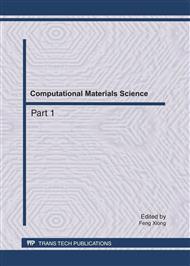[1]
Deng Haiyan. the Differences between Clustering and Judge Analysis. Wuhan Science (2006).
Google Scholar
[2]
Yu Xiang. Research on K-means Algorithm in Clustering Analysis. Harbin: Harbin Engineering University (2007).
Google Scholar
[3]
J. Han, M. Kamber. Data Mining: Concepts and Techniques(China Machine Press, China 2006).
Google Scholar
[4]
B.J. Frey, D. Dueck. Clustering by Passing Messages between Data Points. Science (2007).
Google Scholar
[5]
Jianxiong Xiao, Jingdong Wang, Ping Tan, Long Quan. Joint Affinity Propagation for Multiple View Segmentation. 11th International Conference on Computer Vision (2007).
DOI: 10.1109/iccv.2007.4408928
Google Scholar
[6]
Xie Xinxi, Wang Shitong. Affinity Propagation Clustering for Symbolic Interval Data Based on Mutual Distances. Computer Applications (2008).
DOI: 10.3724/sp.j.1087.2008.01441
Google Scholar
[7]
Frey B J, Dueck D. Mixture Modeling by Affinity Propagation. Neural Information Processing Systems (2006).
Google Scholar
[8]
Xu Wenzhu, Xu Lihong. Adaptive Key-frame Extraction Based on Affinity Propagation Clustering. Computer Science (2010).
Google Scholar
[9]
Qian Chunming. Affinity Propagation Clustering of Applied Research in Remote Sensing Image Classification. Sichuan: Chengdu University of Technology (2009).
Google Scholar
[10]
Marc Mezard. Where are the Exemplars, Science (2007).
Google Scholar
[11]
X.H. Shi, R.C. Guan, L.P. Wang, Z.L. Pei and Y.C. Liang. An Incremental Affinity Propagation Algorithm and Its Applications for Text Clustering, IEEE, (2009).
DOI: 10.1109/ijcnn.2009.5178973
Google Scholar
[12]
Xiao Yu, Yu Jian. Semi-Supervised Clustering Based on Affinity Propagation Algorithm. Journal of Software (2008).
DOI: 10.3724/sp.j.1001.2008.02803
Google Scholar
[13]
Wang Kaijun, Li Jian, Zhang Junying, Tu Chongyang. Semi-supervised Affinity Propagation Clustering. Computer Engineering (2007).
Google Scholar
[14]
Wang Kaijun , Zhang Junying, Li Dan, Zhang Xinna, Guo Tao. Adaptive Affinity Propagation Clustering, Acta Automatica Sinica(2007).
Google Scholar
[15]
Dong Jun. Wang Suoping. Xiong Fanlun. Affinity Propagation Clustering Based on Variable-Similarity Measure. Journal of Electronics and Information Technology (2010).
DOI: 10.3724/sp.j.1146.2009.01066
Google Scholar
[16]
Chen Xiaofeng, Wang Shitong, Cao Suqun. Semi-Supervised Learning Based Kernel Affinity Propagation Clustering Method. Journal of Jiangnan University (2008).
Google Scholar
[17]
Jiang Xiuqin. Research on Semi-Supervise Clustering Algorithm and its Application. Jiangsu: Jiangnan University (2008).
Google Scholar
[18]
Information on http: /genomebiology. com/2002/3/7/research/0036.
Google Scholar
[19]
Gu Ruijun, Wang Jiacai, Chen Geng, Chen Shenglei. Affinity Propagation Clustering for Large Scale Dataset, Computer Engineering (2010).
Google Scholar
[20]
Liu Lei. Adaptive Clustering Algorithm Alaysis Based on k-means. Beijing: Beijing University of Posts and Telecommunications (2009).
Google Scholar
[21]
Wang Lei, Wang Xili, Liu Gaoxia, Zhao Lin. Improved Adaptive Affinity Propagation Clustering based on Semi- Supervised Learning. Application Research of Computers (2010).
Google Scholar
[22]
Yu Jian, Cheng Qiansheng. The Searching Range of Optimal Number of Clusters in Fuzzy Clustering. Science in China (2002).
Google Scholar
[23]
Liu Fei. the Detailed Explanation of Realizing Process of GA. Fujian Computer (2010).
Google Scholar
[24]
Chunguo Wu, Hao Gao, Lianjiang Yu, Yanchun Liang, Rongwu Xiang. Genetic Algorithm with Affinity Propagation, IEEE (2010).
Google Scholar
[25]
Lei Xiaofeng, Yang Yang, Zhang Ke, Xie Kunqing, Xia Zhengyi. Metaheuristic Strategy Based K-Means with the Iterative Self-Learning Framewor. Computer Science (2009).
Google Scholar
[26]
Han Chunyan. An Improved K-means Algorithm. Journal of Neijiang normal University(2009).
Google Scholar
[27]
Yan Zhu, Jian Yu and Caiyan Jia. Initializing K-means Clustering Using Affinity Propagation, Ninth International Conference on Hybrid Intelligent Systems (2009).
DOI: 10.1109/his.2009.73
Google Scholar
[28]
Wang Kaijun, Zheng Jie. Fast Algorithm of Affinity Propagation Clustering under Given Number of Clusters. Computer systems & applications (2010).
Google Scholar


